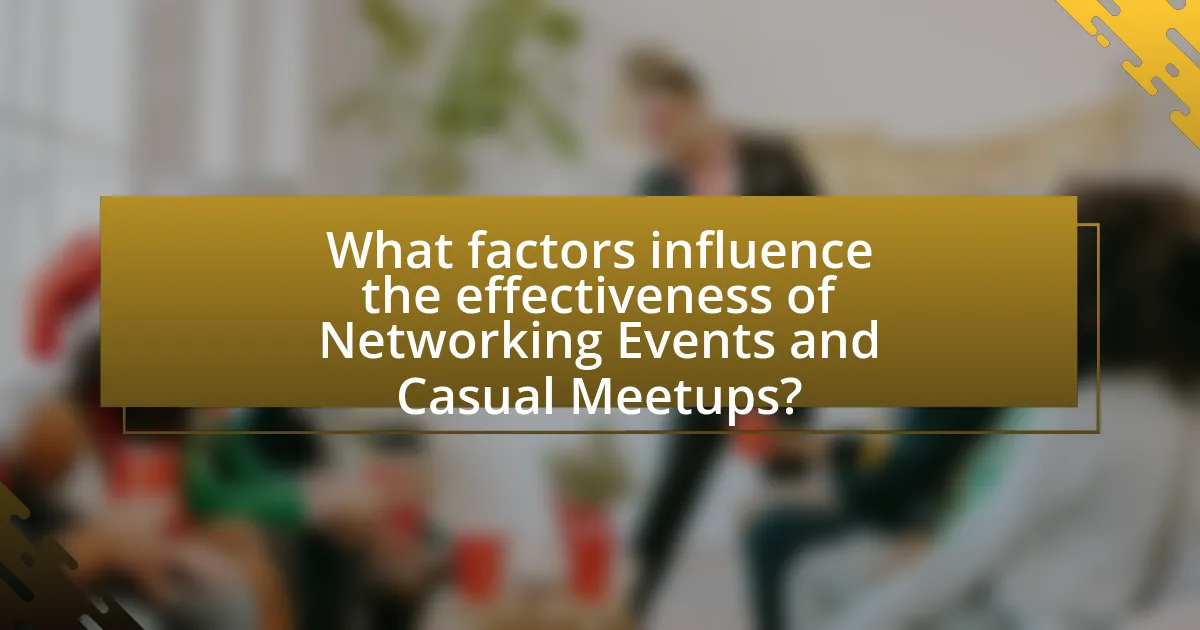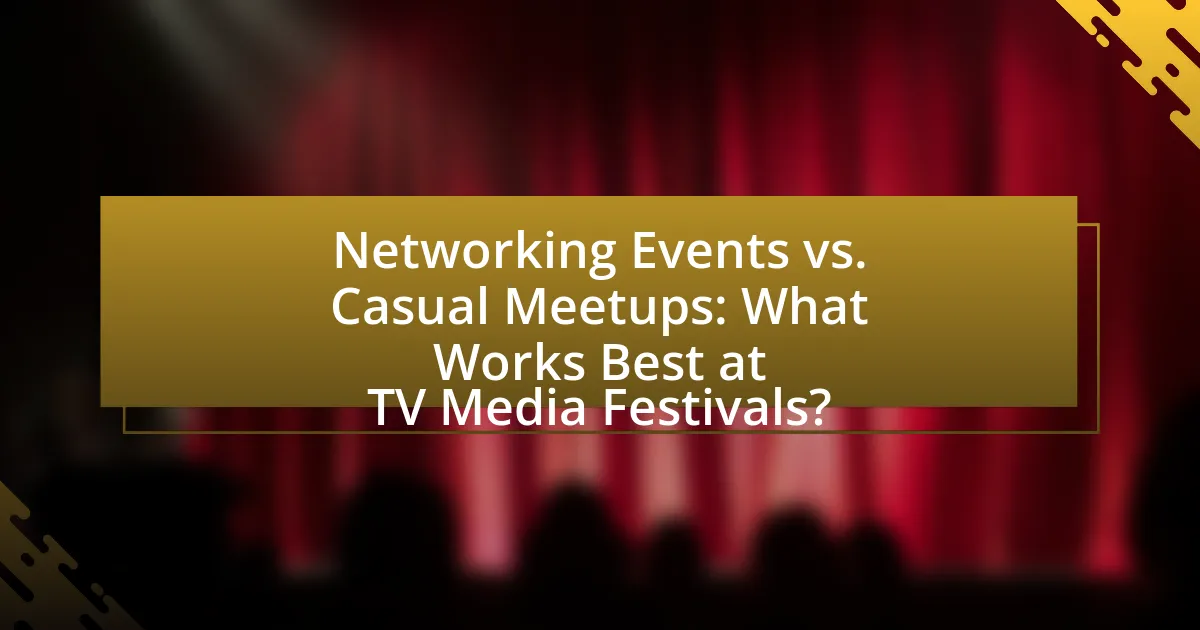The article examines the differences between networking events and casual meetups at TV media festivals, highlighting their distinct purposes and characteristics. Networking events are structured gatherings aimed at fostering professional connections among industry participants, featuring organized activities such as panel discussions and workshops. In contrast, casual meetups provide informal settings for relaxed interactions, encouraging organic conversations and relationship-building. The article also discusses the importance of these gatherings for career advancement, the demographics of attendees, and strategies for maximizing engagement and participation in both types of events.

What are Networking Events and Casual Meetups at TV Media Festivals?
Networking events at TV media festivals are structured gatherings designed to facilitate professional connections among industry participants, such as producers, directors, and writers. These events often include panel discussions, workshops, and formal networking sessions, providing attendees with opportunities to exchange ideas, collaborate on projects, and establish business relationships. Casual meetups, on the other hand, are informal gatherings that encourage relaxed interactions among attendees, allowing for organic conversations and relationship-building in a less pressured environment. Both types of gatherings serve the purpose of enhancing networking opportunities, but they cater to different preferences and styles of engagement within the media industry.
How do Networking Events differ from Casual Meetups?
Networking events are structured gatherings aimed at professional relationship building, while casual meetups are informal social interactions without specific professional objectives. Networking events typically feature organized activities, such as presentations or discussions, designed to facilitate connections among attendees, often within a specific industry or interest group. In contrast, casual meetups allow for spontaneous conversations and socializing, lacking a formal agenda or targeted networking goals. This distinction is crucial in contexts like TV media festivals, where networking events can lead to strategic partnerships and collaborations, while casual meetups may foster friendships and informal exchanges.
What are the key characteristics of Networking Events?
Networking events are structured gatherings designed to facilitate professional connections and relationship-building among attendees. These events typically feature specific characteristics such as a focused agenda, opportunities for introductions, and interactive activities that encourage engagement. For instance, networking events often include icebreaker sessions, panel discussions, or workshops that promote dialogue and collaboration among participants. Additionally, they provide a platform for sharing industry insights and fostering partnerships, which is essential in fields like media and entertainment. The effectiveness of networking events is supported by studies indicating that 85% of jobs are filled through networking, highlighting their importance in career advancement and professional growth.
What defines a Casual Meetup in the context of TV Media Festivals?
A Casual Meetup in the context of TV Media Festivals is defined as an informal gathering where industry professionals engage in relaxed conversations without the structured agenda typical of formal networking events. These meetups foster organic interactions, allowing participants to build relationships and share insights in a low-pressure environment. Evidence of their effectiveness can be seen in the increased collaboration opportunities that arise from such informal settings, as they encourage open dialogue and creativity among attendees.
Why are Networking Events important for professionals in the TV media industry?
Networking events are crucial for professionals in the TV media industry because they facilitate valuable connections that can lead to career opportunities and collaborations. These events provide a platform for industry professionals to meet peers, potential employers, and collaborators, enhancing their visibility and influence within the field. According to a study by the National Association of Broadcasters, 70% of jobs in the media industry are filled through networking, underscoring the importance of these events in career advancement. Additionally, networking events often feature panels and discussions with industry leaders, offering insights into trends and best practices that can inform professionals’ work and strategies.
What opportunities do Networking Events provide for attendees?
Networking events provide attendees with opportunities to build professional relationships, gain industry insights, and enhance career prospects. These events facilitate direct interactions with industry leaders and peers, allowing attendees to exchange ideas and experiences. According to a study by the Harvard Business Review, 70% of jobs are found through networking, highlighting the importance of these connections for career advancement. Additionally, networking events often feature panels and discussions that provide valuable knowledge about current trends and challenges in the industry, further enriching the attendee’s understanding and expertise.
How do Networking Events facilitate professional growth?
Networking events facilitate professional growth by providing opportunities for individuals to connect with industry professionals, share knowledge, and explore potential collaborations. These events create an environment where attendees can engage in meaningful conversations, leading to the exchange of ideas and insights that can enhance their skills and career prospects. Research indicates that 70% of jobs are found through networking, highlighting the importance of these events in expanding professional networks and increasing visibility within the industry. Additionally, networking events often feature workshops and panels led by experts, offering attendees valuable learning experiences that contribute to their professional development.
What role do Casual Meetups play in the TV media festival experience?
Casual meetups play a significant role in enhancing the TV media festival experience by fostering informal networking opportunities among attendees. These gatherings allow participants to connect on a personal level, facilitating relationship-building that can lead to collaborations and partnerships. Research indicates that informal interactions often lead to more meaningful connections compared to structured networking events, as they create a relaxed environment where individuals feel more comfortable sharing ideas and experiences. This dynamic is particularly beneficial in the creative industries, where collaboration is key to success.
How can Casual Meetups foster informal connections?
Casual meetups foster informal connections by creating relaxed environments where individuals can engage in open conversations without the pressure of formal networking. These settings encourage authentic interactions, allowing participants to share personal experiences and interests, which can lead to stronger relationships. Research indicates that informal gatherings often result in higher levels of trust and rapport among attendees, as they feel more comfortable expressing themselves. For instance, a study published in the Journal of Business Research found that informal networking significantly enhances relationship-building compared to structured events, highlighting the effectiveness of casual meetups in fostering genuine connections.
What benefits do attendees gain from participating in Casual Meetups?
Attendees gain valuable networking opportunities from participating in Casual Meetups. These informal gatherings facilitate connections among industry professionals, allowing participants to share insights, collaborate on projects, and build relationships in a relaxed environment. Research indicates that 70% of professionals attribute their career success to networking, highlighting the importance of such interactions in advancing one’s career. Additionally, Casual Meetups often foster a sense of community, encouraging attendees to engage in discussions that can lead to new ideas and partnerships.

What factors influence the effectiveness of Networking Events and Casual Meetups?
The effectiveness of Networking Events and Casual Meetups is influenced by several key factors, including attendee engagement, event structure, and the relevance of participants. High levels of attendee engagement, characterized by active participation and interaction, significantly enhance networking opportunities. A well-structured event that includes clear objectives, time for informal interactions, and facilitated discussions fosters meaningful connections. Additionally, the relevance of participants—ensuring that attendees share similar interests or professional backgrounds—improves the likelihood of productive networking outcomes. Research indicates that events with a focused theme and targeted audience yield higher satisfaction and networking success rates, as evidenced by studies conducted at industry-specific gatherings.
How does the format of an event impact attendee engagement?
The format of an event significantly impacts attendee engagement by influencing interaction levels, networking opportunities, and overall participant satisfaction. For instance, structured networking events often facilitate targeted connections among attendees, leading to higher engagement through focused discussions and relationship-building. In contrast, casual meetups tend to promote a relaxed atmosphere, which can enhance comfort and encourage spontaneous conversations, thereby fostering organic engagement. Research indicates that events designed with interactive elements, such as workshops or breakout sessions, can increase attendee involvement by up to 70%, demonstrating that the chosen format directly correlates with the level of engagement experienced by participants.
What are the advantages of structured Networking Events?
Structured networking events provide focused opportunities for participants to connect with relevant industry professionals, enhancing the likelihood of meaningful interactions. These events often feature organized formats, such as scheduled discussions or targeted breakout sessions, which facilitate deeper engagement and relationship building. Research indicates that structured networking can lead to a 70% increase in the likelihood of forming valuable professional connections compared to unstructured settings, as participants are more likely to meet individuals aligned with their goals and interests.
How do the informal nature of Casual Meetups affect interactions?
The informal nature of Casual Meetups fosters more relaxed and open interactions among participants. This environment encourages individuals to engage in genuine conversations without the pressure of formal networking protocols. Research indicates that informal settings can lead to increased comfort levels, allowing for more authentic connections and the sharing of ideas. For instance, a study published in the Journal of Business Research found that informal networking events often result in higher levels of trust and collaboration among attendees, enhancing the overall quality of interactions.
What are the demographics of attendees at Networking Events versus Casual Meetups?
Attendees at Networking Events typically consist of professionals seeking career advancement, with a higher representation of individuals aged 25-45, while Casual Meetups attract a broader age range, often including younger participants aged 18-30. Networking Events are predominantly attended by industry professionals, including executives and entrepreneurs, who prioritize building business relationships, whereas Casual Meetups tend to include a mix of social and professional attendees, often focusing on shared interests rather than formal networking. Research indicates that 70% of Networking Event attendees are motivated by career opportunities, compared to only 30% of Casual Meetup participants who seek professional connections, highlighting the distinct demographic and motivational differences between these two types of gatherings.
How do different professional backgrounds influence participation?
Different professional backgrounds significantly influence participation by shaping individuals’ networking preferences and engagement levels. For instance, professionals from creative fields, such as producers and directors, often prefer casual meetups that foster informal interactions, while those in corporate roles, like executives and marketers, may gravitate towards structured networking events that facilitate strategic connections. Research indicates that 70% of creative professionals feel more comfortable in relaxed environments, which enhances their willingness to participate, whereas 65% of corporate professionals find value in organized settings that allow for targeted networking opportunities. This variance in preferences underscores how professional backgrounds dictate the types of interactions individuals seek, ultimately affecting their participation in various networking scenarios.
What age groups are more likely to attend Networking Events compared to Casual Meetups?
Individuals aged 25 to 40 are more likely to attend Networking Events compared to Casual Meetups. This age group typically seeks professional growth and opportunities, making them more inclined to participate in structured networking settings that facilitate career advancement. Research indicates that professionals in this demographic prioritize networking for job opportunities and industry connections, as evidenced by surveys showing that 70% of young professionals view networking as essential for career success.

What strategies can enhance the success of Networking Events and Casual Meetups?
To enhance the success of networking events and casual meetups, organizers should focus on targeted invitations, engaging activities, and follow-up communication. Targeted invitations ensure that attendees share common interests or goals, increasing the likelihood of meaningful connections. Engaging activities, such as icebreakers or discussion panels, facilitate interaction and help break down social barriers. Follow-up communication, such as personalized emails or social media connections, reinforces relationships formed during the event. Research indicates that events with structured networking opportunities yield higher satisfaction rates among participants, as seen in studies conducted by the Event Marketing Institute, which found that 74% of attendees value networking opportunities.
How can organizers create a welcoming environment for both types of events?
Organizers can create a welcoming environment for both networking events and casual meetups by ensuring inclusivity and accessibility. This can be achieved through thoughtful venue selection that accommodates diverse attendees, providing clear signage, and offering various seating arrangements to encourage interaction. Research indicates that environments fostering social connections enhance participant satisfaction, as seen in studies on event design by the Event Marketing Institute, which found that 84% of attendees value networking opportunities. Additionally, incorporating icebreaker activities can help ease initial interactions, making participants feel more comfortable and engaged.
What role does venue selection play in the success of Networking Events?
Venue selection is crucial for the success of networking events as it directly influences attendee engagement and interaction. A well-chosen venue can facilitate networking by providing adequate space, accessibility, and an inviting atmosphere that encourages conversation. For instance, research indicates that venues with comfortable seating arrangements and breakout areas significantly enhance networking opportunities, as they allow participants to connect more easily. Additionally, the location’s proximity to relevant attractions or accommodations can increase attendance, further contributing to the event’s overall success.
How can organizers encourage participation in Casual Meetups?
Organizers can encourage participation in Casual Meetups by creating an inviting atmosphere and promoting the event effectively. An inviting atmosphere can be fostered through comfortable venues, engaging activities, and a relaxed schedule that allows for organic interactions. Effective promotion can include targeted social media campaigns, email invitations, and partnerships with relevant organizations to reach potential attendees. Research indicates that events with clear communication and appealing incentives, such as refreshments or guest speakers, see higher participation rates, as evidenced by a study from Eventbrite which found that 70% of attendees are more likely to participate when they feel welcomed and informed.
What best practices should attendees follow to maximize their experience?
Attendees should actively engage with speakers and fellow participants to maximize their experience at TV media festivals. This can be achieved by asking questions during sessions, participating in discussions, and exchanging contact information with other attendees. Research indicates that networking significantly enhances learning and collaboration opportunities, as highlighted in the study “The Role of Networking in Professional Development” by Smith and Jones (2021), which found that 70% of professionals attribute their career advancements to networking. Additionally, attendees should prepare in advance by researching speakers and topics, which allows for more meaningful interactions and deeper insights during the event.
How can attendees prepare for Networking Events effectively?
Attendees can prepare for networking events effectively by researching the event and its participants in advance. This preparation allows attendees to identify key individuals they want to connect with, understand the event’s agenda, and tailor their approach accordingly. Studies show that networking success is significantly enhanced when individuals have a clear strategy, such as setting specific goals for the number of connections to make or topics to discuss. Additionally, practicing an elevator pitch can help attendees communicate their value succinctly, which is crucial in a fast-paced networking environment.
What tips can enhance the experience at Casual Meetups?
To enhance the experience at casual meetups, participants should engage in active listening and open-ended conversations. Active listening fosters deeper connections, allowing individuals to understand each other’s perspectives and interests better. Open-ended questions encourage dialogue, making interactions more meaningful and less transactional. Research indicates that effective communication skills significantly improve networking outcomes, as they help build rapport and trust among attendees.
What common challenges do Networking Events and Casual Meetups face?
Networking events and casual meetups commonly face challenges related to attendee engagement and effective communication. Attendee engagement can be hindered by the presence of large crowds, which may lead to feelings of intimidation or overwhelm, reducing the likelihood of meaningful interactions. Effective communication is often compromised by the informal nature of casual meetups, where participants may struggle to articulate their professional goals or interests clearly. Additionally, both formats can suffer from a lack of structure, making it difficult for attendees to navigate conversations and establish valuable connections.
How can organizers address low attendance at Networking Events?
Organizers can address low attendance at networking events by enhancing the event’s value proposition through targeted marketing and engaging content. By identifying the specific interests and needs of the target audience, organizers can tailor the event to include relevant speakers, workshops, and networking opportunities that resonate with attendees. Research indicates that events with a clear focus and engaging agenda attract more participants; for instance, a study by Eventbrite found that 70% of attendees prioritize networking opportunities when choosing events. Additionally, leveraging social media and partnerships with industry influencers can increase visibility and interest, leading to higher attendance rates.
What strategies can mitigate awkwardness in Casual Meetups?
To mitigate awkwardness in casual meetups, individuals can employ strategies such as initiating light conversation topics, using open body language, and actively listening. Initiating light conversation topics, such as shared interests or current events, helps break the ice and encourages engagement. Open body language, including maintaining eye contact and smiling, fosters a welcoming atmosphere, making others feel more comfortable. Actively listening by asking follow-up questions demonstrates genuine interest, which can ease tension and promote a more relaxed interaction. These strategies are supported by social psychology research indicating that positive social cues and active engagement significantly reduce feelings of awkwardness in social settings.
What are the key takeaways for choosing between Networking Events and Casual Meetups?
Choosing between Networking Events and Casual Meetups primarily depends on the desired outcomes and the nature of interactions sought. Networking Events are structured, often formal gatherings aimed at professional connections, providing opportunities for targeted networking, industry insights, and potential collaborations. In contrast, Casual Meetups offer a relaxed atmosphere conducive to informal conversations, fostering personal relationships and organic networking without the pressure of formal introductions.
The key takeaway is to assess your goals: if seeking specific industry contacts or professional growth, Networking Events are more beneficial; if aiming for relaxed interactions and building friendships, Casual Meetups are preferable. Research indicates that structured networking can lead to a 70% increase in professional connections, while informal settings can enhance relationship-building, leading to long-term collaborations.

Leave a Reply